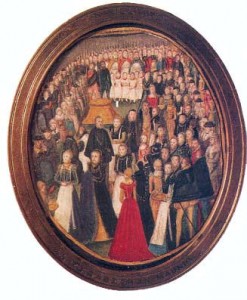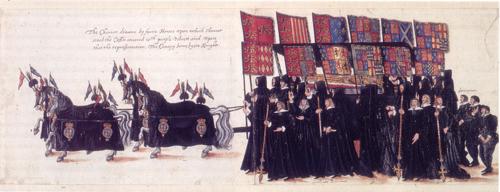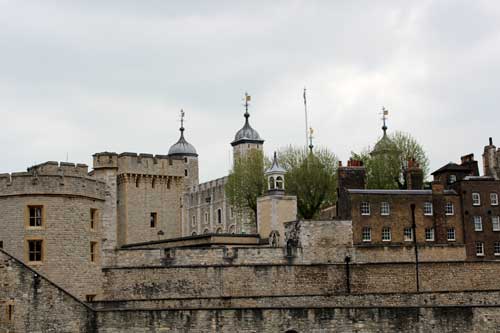Maundy Thursday commemorates the Last Supper, that final meal that Jesus Christ had with his disciples before his arrest.
In Tudor times, on Maundy Thursday, the church was prepared for Easter with water and wine being used to wash the altars and it was traditional for people to go to confession. The three holy oils – the chrism oil, the oil of catechumens and the oil of the sick – were also blessed on this day.
At the Last Supper, which was the Passover meal, Luke's Gospel says that Christ took bread, gave thanks to God for it, broke it and then shared it with his disciples, saying "This is my body given for you; do this in remembrance of me." He then took the cup of wine, saying, "This cup is the new covenant in my blood, which is poured out for you." Christians all over the world remember this gesture by celebrating the Eucharist, also known as "communion". According to John's Gospel, it was at this meal that Jesus washed his disciples' feet, and both Luke and John record Jesus saying that there was one among them who would betray him.
In Medieval times "it became customary for the sovereign to provide a meal and to also give gifts of clothing, food, and money to the poor people involved",1 to commemorate Jesus washing the feet of his disciples, and by the reign of Henry VIII this had developed into washing the feet of poor people with the number of people equalling the monarch's age:
"Each year Henry washed the feet of the number of men who equaled his age and gave each of the poor men whose feet he washed a red purse with the number of pence within it that also equaled his age."2
Henry's queens followed the tradition of giving alms to the poor on Maundy Thursday. In March 1535, Anne Boleyn gave alms and there is a letter in Letters and Papers from Sir Edward Chamberlain and Sir Edmund Bedyngfeld to Cromwell telling him that Catherine of Aragon, who was now known as Princess Dowager, "intends to keep a Maundy, in spite of the King's order of last year to the contrary."3 It was no longer her place to give alms to the poor as she was no longer Queen but she was intent on doing so.
Marco Antonio Faitta, secretary to Cardinal Pole, gave an account of Mary I washing feet on Maundy Thursday 1556:
"Her Majesty being accompanied by the right reverend Legate and by the Council, entered a large hall, at the head of which was my Lord Bishop of Ely as Dean (come Decano) of the Queen's chaplains, with the choristers of her Majesty's chapel. Around this hall on either side there were seated on certain benches, with their feet on stools, many poor women, to the number of forty and one, such being the number of the years of the most Serene Queen. Then one of the menials of the Court having washed the right foot of each of these poor persons, and this function being also next performed by the Under Almoner, and also by the Grand Almoner, who is the Bishop of Chichester, her Majesty next commenced the ceremony in the following manner:—
At the entrance of the hall there was a great number of the chief dames and noble ladies of the court, and they prepared themselves by putting on a long linen apron which reached the ground, and round their necks they placed a towel, the two ends of which remained pendant at full length on either side, each of them carrying a silver ewer, and they had flowers in their hands, the Queen also being arrayed in like manner. Her Majesty knelt down on both her knees before the first of the poor women, and taking in the left hand the woman's right foot, she washed it with her own right hand, drying it very thoroughly with the towel which hung at her neck, and having signed it with the cross she kissed the foot so fervently that it seemed as if she were embracing something very precious. She did the like by all and each of the other poor women, one by one, each of the ladies her attendants giving her in turn their basin and ewer and towel; and I vow to you that in all her movements and gestures, and by her manner, she seemed to act thus not merely out of ceremony, but from great feeling and devotion.
Amongst these demonstrations there was this one remarkable, that in washing the feet she went the whole length of that long hall, from one end to the other, ever on her knees. Having finished and risen on her feet, she went back to the head of the hall, and commenced giving in turn to each of the poor women a large wooden platter, with enough food for four persons, filled with great pieces of salted fish, and two large loaves, and thus she went a second time distributing these alms. She next returned a third time, to begin again, giving to each of the women a wooden bowl filled with wine, or rather, I think, hippocras; after which, for the fourth time, she returned and gave to each of these poor people a piece of cloth of royal mixture for clothing (un pezzo di panno mischio di reale per vestire). Then returning for the fifth time she gave to each a pair of shoes and stockings; for the sixth time she gave to each a leathern purse, containing forty-one pennies, according to the number of her own years, and which in value may amount to rather more than half an Italian golden crown; finally, going back for the seventh time, she distributed all the aprons and towels which had been carried by those dames and noble ladies, in number forty-one, giving each with her own hand.
Her Majesty then quitted the hall to take off the gown which she had worn, and half an hour afterwards she returned, being preceded by an attendant carrying the said gown, and thus she went twice round the hall, examining very closely all the poor women one by one, and then returning for the third time she gave the said gown to the one who was in fact the poorest and most aged of them all; and this gown was of the finest purple cloth, lined with martens' fur, and with sleeves so long and wide that they reached the ground. During this ceremony the choristers chaunted the miserere, with certain other psalms, reciting at each verse the words—
“In diebus illis mulier quæ erat in civitate peccatrix.”"4
Elizabeth I continued the tradition in her reign too.
Although the feet washing ritual stopped in the UK in the 18th century, our present Queen, Elizabeth II, visits a church or cathedral on Maundy Thursday for a special service where she presents local pensioners with Maundy money. In 2016 the service, which was invitation only, was held at St George's Chapel, Windsor Castle. The College of St George's website explained:
"The gifts distributed to the recipients are symbolic; a red purse which contains a nominal allowance for clothing and provisions formerly given in kind and a white purse containing Maundy coins of as many pence as the Sovereign has years of age. The act of washing feet stopped in the 18th century but some of those who take part in the service nowadays still wear linen towels over their robes or clothes. In 2016 the Maundy distribution consists of:
In a white purse - Maundy coins (silver pennies, twopences, threepences and fourpences) adding up to 90 pence (9 sets of ten pence).
In a red purse - A £5 coin commemorating The Queen's ninetieth birthday and a 50p coin commemorating the nine hundred and fiftieth anniversary of the Battle of Hastings. Both coins have been minted in 2016. Historically, the sum of £5.50 in the red purse is made up of £3 for clothing, £1.50 in lieu of provisions and £1 for the redemption of the Sovereign's gown which, before Tudor times, used to be divided between the Recipients."5
Isn't it wonderful that such an old tradition is being carried on today?
Notes and Sources
- Levin, Carole (1989) “Would I Could Give You Help and Succour”: Elizabeth I and the Politics of Touch, University of Nebraska, Published in ALBION: A QUARTERLY JOURNAL CONCERNED WITH BRITISH STUDIES, Vol. 21, No. 2 (Summer, 1989), p194.
- Ibid.
- Letters and Papers, Foreign and Domestic, Henry VIII, Volume VIII, 428.
- Calendar of State Papers, Venice, Volume VI, 473, Marco Antonio Faitta to Ippolito Chizzola Doctor in Divinity.
- Royal Maundy 2016, http://www.stgeorges-windsor.org/about-st-georges/news1/news-archive/2016/royal-maundy-2016.html
CSP Venice Volume vi. 473




Yes, I do like that that tradition is carried on today 🙂
I had no idea! I am very moved in reading about Elizabeth I washing the feet of the poor women. I want to read more about this very beautiful ceremony.
Foot washing takes place in every Catholic Church still and I assume the Maundy Money is still distributed. I don’t think the Queen goes up and down several times. Its a beautiful ceremony to read about.
I like that Queen Katharine gave Maundy Money despite the King saying she couldn’t.
Anne was reported to be very generous with her Maundy Money. She was reported as being generally generous, but you would want to be more generous than your predecessor. Queen Mary’s ceremony is very elaborate. Of course Jesus did it without all the ceremony.
I was interested in the Maundy rites, as I knew what Maundy Thursday was, but being a secular Jew and Humanitaria, I didn’t have experience of the ceremony. Thank you so much, Claire.
Technically, I will be honest as I had only heard of my favourite Sovereign (Mary I of England) doing it, I didn’t know it was a tradition. My favourite Monarch was a pious Catholic and she continues to be the best monarch that Britain had ever had.